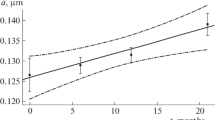Abstract
A method for the synthesis of a nanostructured turpentine oil lyosol by bubbling an emulsion of turpentine oil in water with air in a mass ratio of 1:200 to 1:2200 by the separation of nanoparticles using nanofiltration has been proposed. Changing the mass ratio of turpentine oil to the aqueous phase during the synthesis was shown to influence the size of the resulting nanoparticles. An increase in the Z-average size of nanoparticles from 50 to 320 nm along with a gradual decreasing turpentine content from 1:200 to 1:1000 was observed. A further decrease in the turpentine load from 1:1000 to 1:2200 led to decreasing the Z-average particle size up to 160 nm. The fact of the formation of stable non-covalent complexes of the lyosol particles with fluorescein has been established. The fluorescein-stained lyosol particles were used to study the efficiency of their phagocytosis by chicken blood monocytes using confocal microscopy. The maximum efficiency of the lyosol phagocytosis by the chicken monocytes was observed when the Z-average lyosol particle size was ~ 50 nm, which was achieved with a turpentine dry matter ratio of 1:200 during the synthesis.





Similar content being viewed by others
References
Audibert, F. M., & Lise, L. D. (1993). Immunology Today, 14(6), 281–284. https://doi.org/10.1016/0167-5699(93)90046-N
Chen, X. Q., Zou, J. S., Tu, L., Yun, X., & Qin, Y. H. (2023). PLoS ONE, 18(7), e0288538. https://doi.org/10.1371/journal.pone.0288538
Brito, L. A., Malyala, P., & O’Hagan, D. T. (2013). Seminars in Immunology, 25(2), 130–145. https://doi.org/10.1016/j.smim.2013.05.007
Chakraborty, S., Ye, J., Wang, H., Sun, M., Zhang, Y., Sang, X., & Zhuang, Z. (2023). Frontiers in Immunology, 23(14), 1227833. https://doi.org/10.3389/fimmu.2023.1227833
Tyn'o, J. J., Novikov, V. E., Jarygina, E. I., & Ustinova, V. A. (2015). Method and device for obtaining stable ultradisperse water lyosoles of turpentine oil with given dispersion parameters. Patent Russia, 2566068.
O’goshi, K., & Serup, J. (2006). Skin Research and Technology, 12(3), 155–61. https://doi.org/10.1111/j.0909-752X.2006.00147.x
Crowley LC, Marfell BJ, Waterhouse NJ. Cold Spring Harbor Protocols. 2016; 2016(9). https://doi.org/10.1101/pdb.prot087205.
Waeckel, L., Khenine, H., Berger, A. E., & Lambert, C. (2023). Cytometry Part A, 103(9), 732–735. https://doi.org/10.1002/cyto.a.24780
Dalzon, B., Torres, A., Reymond, S., Gallet, B., Saint-Antonin, F., Collin-Faure, V., Moriscot, C., Fenel, D., Schoehn, G., Aude-Garcia, C., & Rabilloud, T. (2020). Nanomaterials (Basel), 10(2), 266. https://doi.org/10.3390/nano10020266
Manmohan, S. (2007). Vaccine Adjuvants and Delivery Systems. John Wiley and Sons Hoboken, New Jersey.
Filippenko, A. V., Trufanova, A. A., Ivanova, I. A., & Omelchenko, N. D. (2023). Journal of Microbiology Epidemiology Immunobiology, 100(3), 237–246. https://doi.org/10.36233/0372-9311-339
Isaenko, E. Yu., Babich, E. M., Eliseeva, I. V., Zhdamarova, L. A., Belozersky, V. I., & Kolpak, S. A. (2013). Annals of Mechnikov Institute, 4, 5–21.
Alkrad, J. A., Mrestani, Y., & Neubert, R. H. H. (2016). European Journal of Pharmaceutical Sciences, 30(86), 84–90. https://doi.org/10.1016/j.ejps.2016.02.008
Garçon, N., Vaughn, D. W., & Didierlaurent, A. M. (2012). Expert Review of Vaccines, 11(3), 349–366. https://doi.org/10.1586/erv.11.192
Starodubova, E. S., Preobrazhenskaya, O. V., Kuzmenko, Y. V., Latanova, A. A., Yarygina, E. I., & Karpov, V. L. (2015). Molecules Biology, 49(4), 577–84.
Yeruham, I., Yadin, H., Haymovich, M., & Perl, S. (2001). Veterinary Dermatology, 12(4), 197–201. https://doi.org/10.1046/j.0959-4493.2001.00221.x
Ludi, A. B., Horton, D. L., Li, Y., Mahapatra, M., King, D. P., Knowles, N. J., Russell, C. A., Paton, G. J., Wood, J. L. N., Smith, G. J., & Hammond, L. M. (2014). Journal of General Virology, 95(Pt 2), 384–392. https://doi.org/10.1099/vir.0.057521-0
Elnekave, E., Even-Tov, B., Gelman, B., Sharir, B., & Klement, E. (2015). Journal of Veterinary Science, 16(1), 87–92. https://doi.org/10.4142/jvs.2015.16.1.87
Pokrovsky, A. G., Plyasunova, O. A., Ilyicheva, T. N., et al. (2001). Chemistry for Sustainable Development, 9, 485–491.
Krasilnikov, I. V., Ivanov, A. V., Nikolaeva, A. M., Mashin, V. V. (2011). Siberian Journal of Clinical and Experimental Medicine, 26(2), 65–67.
Acknowledgements
Spectral measurements were carried out on the basis of the collective scientific center of the Institute of Biochemical Physics of the Russian Academy of Sciences “New Materials and Technologies” under the state assignment “Kinetics and mechanism of elementary stages of complex photochemical processes,” supported by the State program of the Russian Federation for the Institute of Biochemical Physics named after Emanuel, Russia, Academy of Sciences (project No. 122041400114-2).
Funding
The work was carried out with the financial support of the Additional Agreement to State Assignment No. 075–03-2023–346/1 dated February 27, 2023.
Author information
Authors and Affiliations
Contributions
AVS carried out experiments based on methods of spectrofluorometry and confocal microscopy, OPB synthesized all specimens of the lysole described in the MS, YYT proposed the principle of the lysole synthesis and application, EVT edited the text and prepared it for publication, AVB carried out nanofiltration experiments, EYE carried out calculations of the lyosol yield, ESB prepared the figures, MAD prepared cell culture used in the biological trials, VAK proposed the method of the lyosol staining with the fluorescein dye.
Corresponding author
Ethics declarations
Competing interests
The authors declare no competing interests.
Ethical Approval
In vivo experiments were carried out in accordance with the ethical requirements of the European Convention for the protection of vertebrates used for experiments or other scientific purposes (Strasbourg, March 18, 1986) ETS N123. The experimental protocol was approved at a meeting of the Local Ethics Committee of the VIGG (Protocol No. 1 dated 03.06.2020).
Research Involving Humans and Animals Statement
None.
Informed Consent
None.
Additional information
Publisher's Note
Springer Nature remains neutral with regard to jurisdictional claims in published maps and institutional affiliations.
Rights and permissions
Springer Nature or its licensor (e.g. a society or other partner) holds exclusive rights to this article under a publishing agreement with the author(s) or other rightsholder(s); author self-archiving of the accepted manuscript version of this article is solely governed by the terms of such publishing agreement and applicable law.
About this article
Cite this article
Shibaeva, A.V., Bokareva, O.P., Tynyo, Y.Y. et al. Synthesis, Structural Characteristics, and Evaluation of the Antigen-Presenting Properties of Turpentine Oil Lyosol. BioNanoSci. (2024). https://doi.org/10.1007/s12668-024-01390-4
Accepted:
Published:
DOI: https://doi.org/10.1007/s12668-024-01390-4




